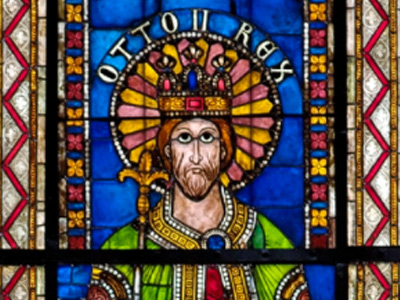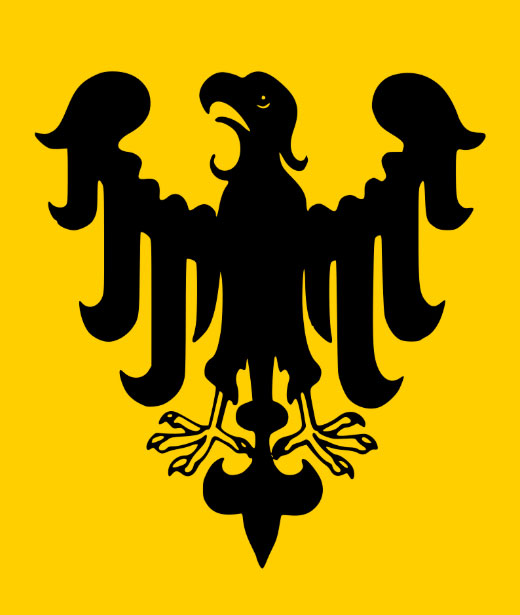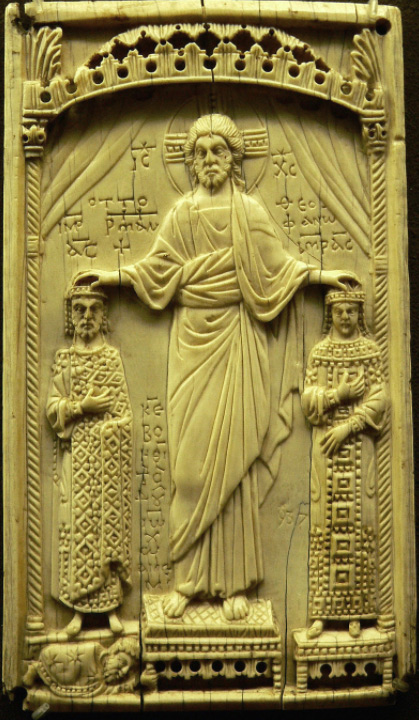Otto II, Holy Roman Emperor (955-983)
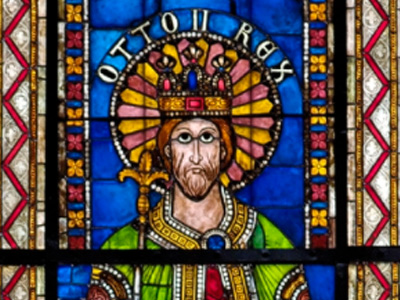
Reign as Emperor
Coronation and Domestic Strife
When Otto the Great died, the smooth succession to the imperial throne of Otto II had long been guaranteed. Otto II had been king of Germany for twelve years and Emperor for five at the time of Otto the Great's death. Unlike his father, Otto II did not have any brothers to contest his claims to the throne. On May 8, the nobles of the Empire assembled before Otto II and, according to the Saxon Chronicler Widukind of Corvey, "elected" Otto II as his father's successor. One of Otto II's first acts was to confirm the rights and possessions of the Archbishop of Magdeburg. Although Otto II had succeeded peacefully to the throne, internal divisions of power still remained unaddressed. During his first seven years as Emperor, he was constantly occupied with maintaining Imperial power against internal rivals and external enemies.
The domestic problems Otto the Great faced between 963 and 972 had not been resolved by his death. The Saxon nobility continued to resist the Archdiocese of Magdeburg located along the Empire's eastern border. Though established by Otto I, the exact details of the diocese's boundaries were left to Otto II and his aides. Otto II's marriage to the Byzantine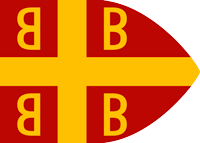 The Byzantine Empire, also referred to as the Eastern Roman Empire or Byzantium, was the continuation of the Roman Empire primarily in its eastern provinces during Late Antiquity and the Middle Ages, when its capital city was Constantinople. It survived the fragmentation and fall of the Western Roman Empire in the 5th century AD and continued to exist for an additional thousand years until the fall of Constantinople to the Ottoman Empire in 1453. Princess Theophanu proved to be to his disadvantage because the Saxon nobles felt it distanced the Emperor from their interests. Among Otto II's chief advisors, only the Saxon Bishop Dietrich I of Metz had close connections with the old Saxon nobility. His other advisers lacked support from the Empire's various Dukes. The Archbishop of Mainz Willigis, appointed in 975, who had been with Otto II's advisor since Otto the Great's second expedition into Italy in the 960s, had not been born from a noble family. Hildebald of Worms, who had been appointed as Otto II's Chancellor in 977 and then as Bishop of Worms in 979, was also not from a noble family.
The Byzantine Empire, also referred to as the Eastern Roman Empire or Byzantium, was the continuation of the Roman Empire primarily in its eastern provinces during Late Antiquity and the Middle Ages, when its capital city was Constantinople. It survived the fragmentation and fall of the Western Roman Empire in the 5th century AD and continued to exist for an additional thousand years until the fall of Constantinople to the Ottoman Empire in 1453. Princess Theophanu proved to be to his disadvantage because the Saxon nobles felt it distanced the Emperor from their interests. Among Otto II's chief advisors, only the Saxon Bishop Dietrich I of Metz had close connections with the old Saxon nobility. His other advisers lacked support from the Empire's various Dukes. The Archbishop of Mainz Willigis, appointed in 975, who had been with Otto II's advisor since Otto the Great's second expedition into Italy in the 960s, had not been born from a noble family. Hildebald of Worms, who had been appointed as Otto II's Chancellor in 977 and then as Bishop of Worms in 979, was also not from a noble family.
Otto the Great also failed to clarify affairs in Italy prior to his death. Otto died soon after the appointment of Pope Benedict VI in 973. In 974 Benedict was imprisoned in the Castel Sant'Angelo, the stronghold of the Crescentii family. When Otto II sent an imperial representative, Count Sicco, to secure his release, Crescentius I and Cardinal-Deacon Franco Ferrucci, who would subsequently become Boniface VII, an antipope, had Benedict murdered while still in prison.
Following his coronation, a rift developed between Otto II and his mother, the Dowager Empress Adelaide of Italy. From the death of Otto the Great until Easter 974, Adelaide accompanied the Emperor at all times, traveling throughout the Empire with him. However, Otto II's mother and his wife Theophano each distrusted the influence the other held over the Emperor, causing friction within the Imperial household. A final meeting between Otto II and Adelaide was arranged shortly before Pentecost in 978, but a peaceful outcome was not achieved, forcing Adelaide to retire to Burgundy and to the protection of her brother King Conrad of Burgundy.
Conflict with Henry II
Otto II sought continued peace between himself and the descendants of his uncle Henry I, Duke of Bavaria. To ensure domestic tranquillity, Otto II, on June 27, 973, granted his cousin, Henry II, Duke of Bavaria, control over the imperial castles in Bamberg and Stegaurach. This was not enough for the young Bavarian Duke, who wished to extend his influence in the Duchy of Swabia as his father had under Otto the Great. The death of Bishop Ulrich of Augsburg on July 4, 973, brought the conflict between the cousins to a head. Without consulting Otto II, Henry II named his cousin Henry as the new Bishop of Augsburg. Augsburg was located on the western side of the Swabian-Bavarian border, the territory of Henry II's brother-in-law Burchard III, Duke of Swabia. Henry's actions in naming a bishop in a duchy not his own and without Imperial direction brought him into conflict with both Otto II and Burchard III. Not desiring civil war, Otto II, on September 22, 973, invested Henry as bishop.
On November 12, 973, Burchard III died with no heir: his union to Hadwing, sister of Henry II, had produced no children. With no clear successor, Henry II demanded that Otto II name him as the new Duke of Swabia. The Emperor sensed the far-reaching ambitions of his cousin and denied his request. Instead, Otto II named as Duke his nephew Otto, son of his half-brother Liudolf, Duke of Swabia. Prior to his appointment, Otto had been a long-time opponent of Henry II's expanding influence in Swabia. By naming a descendant of his half-brother instead of his cousin, Otto II reinforced his father's policy of appointing close family members to key posts throughout the Empire. This appointment elevated the descendants of Otto the Great above those of Henry I in the selection process, further dividing Otto II and Henry II.
The appointment of Otto as Duke of Swabia was taken by Henry II as an assault on his claim to the Imperial throne and a slight to his honor. He and his advisor, Bishop Abraham of Freising, conspired with the Duke of Poland Mieszko I and the Duke of Bohemia Boleslaus II against Otto II in 974. While the historical sources do not describe the goals of the conspirators, Henry II likely intended to restore his honor and to ensure his position as the second most influential man in the Empire. Upon hearing of the conspiracy, Poppo, the Bishop of Würzburg, demanded Henry II and his followers to submit to Otto II or face excommunication. Otto the Great's efforts to consolidate the Church under Imperial control had made this type of action normal. Henry II and his followers complied and submitted to Otto II before armed conflict broke out. Otto II, however, severely punished this conspirators: Henry II was imprisoned at Ingelheim and Bishop Abraham at Corvey.
By 976, Henry II returned to Bavaria. Whether Otto II released him from prison or if he escape is not known for certain. Upon his return, Henry came into open rebellion against Otto II, claiming rulership over the Empire for himself. Henry II mobilized the Saxon nobility against Otto II. In particular, Henry II had strong connections to Margrave Gunther of Merseburg, Count Egbert the One-Eyed, and Dietrich I of Wettin, who were all displeased with Otto II's lack of adherence to Saxon tradition. In response to the rebellion, Otto II stripped Henry II of his Duchy and had him excommunicated. Otto II then marched his army south to Bavaria and laid siege to Regensburg, Henry II's stronghold. Otto II's army eventually broke through the city's defenses, forcing Henry II to flee to Bohemia.
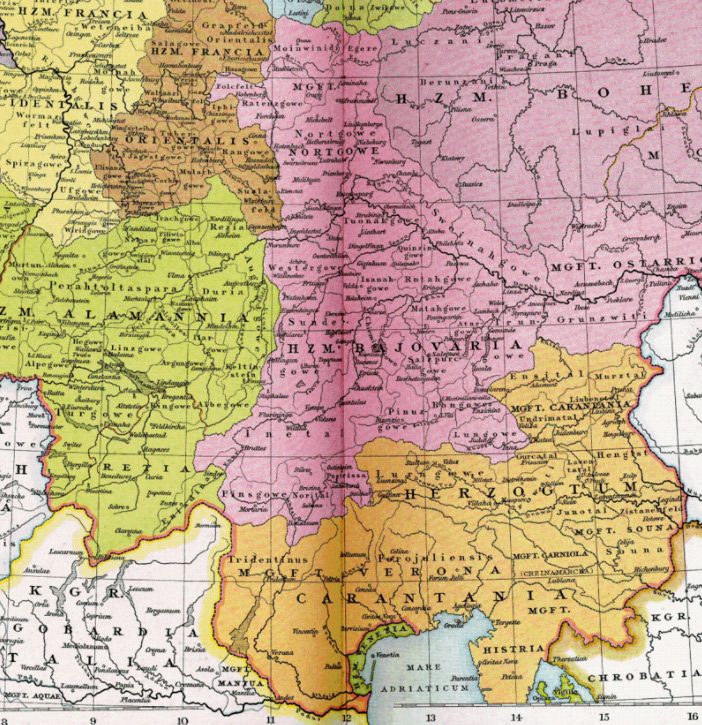
The Duchy of Carinthia (orange) was created by Otto II from confiscated territory of the Duchy of Bavaria (purple)
With Henry II deposed, in July 976 Otto II issued far-reaching edicts on the reorganization of the southern German duchies. Otto II reduced the Duchy of Bavaria in territorial size by almost a third. From the confiscated Bavarian territory, Otto II established the Duchy of Carinthia in southern Germany. By depriving Bavaria of the March of Verona, Otto II considerably reduced the influence of the Bavarian Dukes in northern Italy and in general Imperial policy regarding Italy. Otto II gave the newly diminished Duchy of Bavaria to his relative Otto, the Duke of Swabia, and appointed Henry III, son of the former Bavarian Duke Berthold, as Duke of Carinthia. These appointments continued his policy of appointing of individuals who had no political links to Otto the Great, including those who had even rebelled against him.
With matters in southern Germany settled, Otto II turned his attention to defeating and capturing Henry II. After a failed first invasion into Bohemia, Otto II marched to Bohemia a second time in August 977. While in Bohemia, a revolt broke out in Bavaria. Henry I, Bishop of Augsburg, and the newly appointed Carinthian Duke Henry III joined Henry II in rebellion, forcing Otto II to return from Bohemia. The Emperor, aided by the Duke of Swabia and Bavaria, met the rebels at Passau and, after a long siege, forced them into submission. Otto II then brought the rebels before the Imperial Diet in Quedlinburg on March 31, 978. Boleslaus II was treated with honors and swore loyalty to Otto II. Mieszko I of Poland recognized Otto's royal authority to the throne. Otto II imprisoned Henry II under the custody of the Bishop of Utrecht where he would remain until Otto II's death in 983.
While Otto the Great had pardoned rebellious family members for their crimes, Otto II followed a different policy. Instead, Otto II hoped to subordinate the Bavarian line of Ottonians to his Imperial authority. Henry II's four-year-old son, also named Henry, was sent to Hildesheim to study for an ecclesiastical career. It appears Otto II intended to end the Bavarian Ottonians' secular control of Bavaria. Under a new Duke, Bavaria would remain a remote area of the Empire. Otto II would only visit the Duchy three times during his reign, in all cases accompanied by the military.
War with Denmark
In 950, Otto the Great had subdued the Kingdom of Denmark and forced the Danish King Gorm the Old to accept him as his overlord. Otto the Great also forced the king and his heir apparent Harald Bluetooth to convert to Christianity. Under the reign of Otto the Great, Denmark fulfilled all its obligations and regularly paid tribute to the Germans. When Harald became king in 958, he expanded the control of his kingdom into Norway, becoming king there in 970. With his newly obtained power, the young ruler was no longer willing to accept German supremacy over his kingdom. In summer 974, Harald rebelled against Otto II. With the support of Norwegian troops, Harald was able to cross the Danish border into Germany, defeating the German forces stationed in the north. Otto II attacked Harald's forces, but the joint Danish-Norwegian army repelled the German army. In autumn, however, when the Norwegian allies sailed north to return to Norway, Otto II was able to counter Harald's advances at the Danevirke. As a result of this victory, Otto II officially annexed Denmark into the Empire and exiled Harald to Norway.
War against France
Before Henry II's civil war in southern Germany erupted, Otto II was faced with disputes in western Germany. The brothers Reginar IV, Count of Mons, and Lambert I, Count of Louvain, demanded that the Emperor restore their confiscated inheritance in the Duchy of Lorraine. Years earlier in 958, Otto the Great banished their father Reginar III, Count of Hainaut, to Bohemia after he attempted a failed revolt. In 973, Otto II granted their request. With both Otto the Great and Count Reginar III dead, it appears Otto II desired a fresh start with the two sons. Lambert I and Reginar IV returned to Lorraine in 973 to reclaim their land by force. After an initial failure, the brothers attempted again in 976, this time with the support of King Lothar of France. To help calm the situation in the west, Otto II appointed Charles, his cousin and brother of Lothar, as Duke of Lower Lorraine. The same year, Otto II appointed Egbert as his Imperial Chancellor.
Otto II's support of Charles, however, infuriated the French king, who claimed the Duchy as his own territory. Charles and Lothair were also feuding, with Charles being exiled from France over infidelity allegation concerning Lothair's wife. Charles fled to Otto II's court and paid homage to Otto II. In return, Otto II appointed Charles as Duke and promised to support him in claiming the French throne. Soon after Otto II crushed Henry II's revolt in the south, the Emperor and his wife Theophanu returned to the old capital of Aachen in Lorraine. With the Imperial family near the French border, Lothair invaded Lorraine and marched on Aachen. With the French army in sight, Otto II and Theophano fled to Cologne and then to the Duchy of Saxony. Upon hearing of the French invasion, Otto II’s mother Adelaide of Italy, who was Lothair's mother-in-law, sided with Lothair over her own son and moved to the court of her brother King Conrad of Burgundy. After occupying Aachen for five days, Lothair returned to France after symbolically disgracing the city.
Otto II convened the Imperial Diet in mid-July at Dortmund. There, Otto II declared war against France and prepared his army to march west. In September 978, Otto II retaliated against Lothair by invading France with the aid of Charles. He met with little resistance on French territory, devastating the land around Rheims, Soissons, and Laon. Otto II then had Charles crowned as King of France by Theodoric I, Bishop of Metz. Lothair then fled to the French capital of Paris and was there besieged by Otto II and Charles. Sickness among his troops brought on by winter and a French relief army under Hugh Capet forced Otto II and Charles to lift the siege on November 30, and to return to Germany. On the journey back to Germany, Otto's rearguard was attacked and destroyed by French forces, with their supplies being captured. Despite neither side obtaining a clear victory, Otto II felt his honor was sufficiently restored and opened peace negotiations with the French King. Peace was finally concluded between Otto II and Lothair in 980: in return for renouncing his claims on Lorraine, Otto II would recognize Lothair's son Louis V as the rightful heir to the French throne.
With peace concluded, Otto II returned to Aachen to celebrate Pentecost, and then moved towards Nijmegen. During the journey, in late June or early July 980, the Empress Theophanu gave birth to the Imperial couple's only son: Otto III.
HISTORY
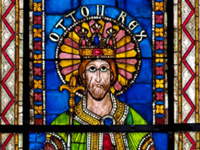
RESOURCES
This article uses material from the Wikipedia article "Otto II, Holy Roman Emperor (955-983)", which is released under the Creative Commons Attribution-Share-Alike License 3.0.
© Stories Preschool. All Rights Reserved.
